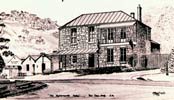


The Highercombe Hotel building has served as a meeting place for the Tea Tree Gully community since the early days of settlement in the area.
Built in 1853-54, the building was operated as a hotel for twenty-four years. During that time the largest room was used for a variety of public functions including council meetings, lodge meetings and dances. In 1855 ‘qualified voters of the District of Yatala’ petitioned the Governor of South Australia to name the Highercombe Hotel as a polling place for the forthcoming elections stating that: ‘It is a more central place than Houghton village, being in the midst of a much larger population and having very superior accommodation for the transaction of public business.’ The petition was granted. In 1875 the main road was re-routed past the front door of the nearby Tea Tree Gully Inn, which then became the major stopping place for coaches and change of horses. At that time the community could not support two public houses, so the Highercombe Hotel closed in 1878. William Haines Jnr was the last of five licensees.
In 1879, Haines, then Member of Parliament for the District of Gumeracha, and forty-eight residents of Tea Tree Gully, successfully petitioned the Government ‘. . . to establish a Telegraph and Post Office at Tea Tree Gully in the buildings which the Government recently proposed to purchase’, the Highercombe Hotel.
The northern side of the old hotel served as the Tea Tree Gully Post Office from 1879 to 1963; first under the state postal service, then after federation with the Federal Posts and Telegraphs service. It also served as residence for the postal officer.
The southern side of the building served as the residence of the head teacher of the Tea Tree Gully Public School from 1875 to 1934. In the 1890s the number of pupils in the school overflowed the single schoolroom nearby, and the assembly room was pressed into service. The restriction on other public use of the meeting room resulted in the erection of the Institute Hall in 1896.
After the Headmaster vacated the premises, the State Government leased the southern side of the building as a private residence to the Hughes Family during the 1930-1950s.
From 1963–1965 the building was used as a library and office accommodation for the Tea Tree Gully Council. After that, the building was derelict for some time and destined for demolition.
At the request of concerned local citizens, the site was bequeathed to the National Trust of South Australia (NTSA) in 1967. Volunteers forming the NTSA Tea Tree Gully Branch began development as a heritage museum with donation of contents from local residents. It was initially known as the Old Highercombe Hotel Folk Museum and later, the Old Highercombe Hotel Museum.
In 2012 the Museum achieved ACCREDITATION in History SA's Community Museums Program - meeting a level of excellence against the National Standards for Australian Museums and Galleries. Through five yearly reviews, it gained re-accreditation in 2018 and 2024 in the (now) Museums and Collections (MaC) program of the History Trust of SA.
After several years of extensive expansion of displays on site beyond the original hotel building, in 2015 the facility was re-born as the Tea Tree Gully Heritage Museum.
The State Government passed Title of the property to NTSA in 2018.
As a museum operated by community volunteers, the building continues to be a meeting place for the community: a place where the present meets the past.